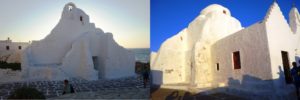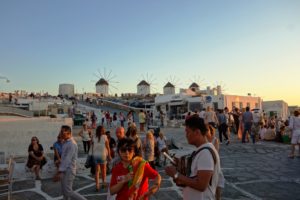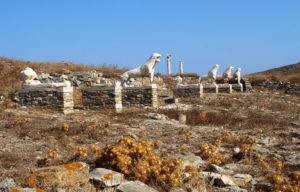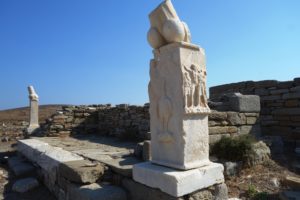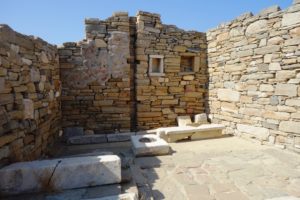This pic is of a famous Church which started at 5 separate chapels and was combined with additional construction into one building. It’s iconic, but I included it because it shows how dramatic the light can be in Greece. The two pictures are of the same building. One is shot with the sun setting behind the building. The other is from the other side with the sunset light shining on the building.
This is the other iconic view of old town Mykonos. The windmills were the primary source of income before 1970. There was almost no farming, but steady winds. These mills ground much of the grain for Greece. The picture also gives an idea of the crowds of people in town. We walked through Little Venice and I felt uncomfortable from the crowding. This was with only one cruise ship in port. I can’t begin to imagine what it’s like when there are 5 or 6 ships in port (which is a common thing).
Today we visited Delos, a 20-minute ride in a small ferry. Once Delos was the most important city in the Aegean sea, and one of the most important in the world. Today, it is a total ruin. Only a few guards live on the island. Back in the day, Delos was populated because it had trees, a river, and a lake. The Greeks needed a place to rest and provision their ships.
Before long, it had become a religious sanctuary for all of Greece. When Athens defeated the Persians and formed the Athens league, they stored the league treasure on Delos, and the island became even more important. As I wrote yesterday, Athens moved the treasury to their own city and used it to build the Acropolis. This triggered the Peloponnesian wars, which Athens lost.
This was the end of an era, but it also created new opportunities. It removed Athens from control of Delos. Delos quickly became even more important as an international free-trade zone. Every major country had representation on the island, and almost everything was traded. The major profit was in wheat and slaves. The ultra-rich came to the island to show off and make themselves even richer through business and trade. The Villa of Dionysos (named after the subject of the mosaic on the floor of the courtyard) was the biggest and richest house.
This was definitely a place where the tour guide added a lot to the visit. With very little to see, a lot of interpretation is required to understand the importance of Delos to the ancient world. The most entertaining ruin was the temple to Dionysus, which the Romans renamed Bacchus. The god of wine, dancing, and emotional excess was represented with two statues of a phallus.
Delos included a theater and other things contained in any important city. I won’t bore you with all the pictures. However, this picture of typical construction is interesting. Walls were built with stone and painted with adobe. Notice there is no mortar used in this construction. Our tour guide said this type of construction is more difficult. But I think the mild weather and the lack of importance in keeping the cold wind out might have been an important factor in their using this building technique.

